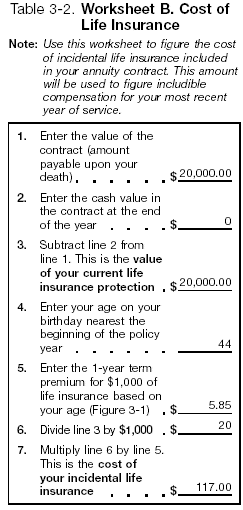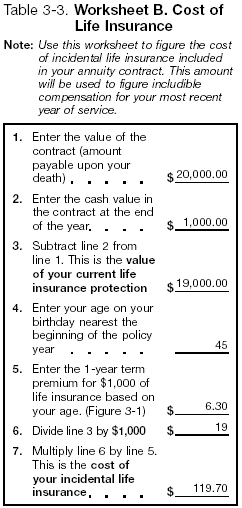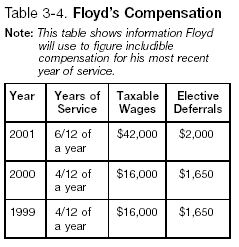Includible Compensation for Your Most Recent Year of Service
For 2002, you will need to figure your includible compensation for your most recent year of service for purposes of figuring your limit on annual
additions as discussed in Chapter 9.
After you have figured your years of service, the next step in figuring your MEA is determining your includible compensation for your most recent
year of service. When figuring includible compensation for your most recent year of service, do not mix compensation or service of one employer with
compensation or service of another employer.
Most Recent Year of Service
Your most recent year of service is your last full year of service, ending on the last day of your tax year that you worked for the employer that
maintains a 403(b) account on your behalf. To figure your most recent year of service, you will need to understand the rules discussed under
Years of Service, earlier.
When determining your includible compensation, for purposes of figuring your MEA, keep in mind that your most recent year of service may not be the
same as your employer's most recent annual work period. This can happen if your tax year is not the same as your employer's annual work period.
Tax year different from employer's annual work period.
If your tax year is not the same as your employer's annual work period, your most recent year of service is made up of parts of at least two of
your employer's annual work periods.
Example.
A professor who reports her income on a calendar-year basis is employed on a full-time basis by a university that operates on an academic year
(October through May). For purposes of figuring her MEA for 2001, the professor's most recent year of service consists of her service performed during
January through May of 2001 and her service performed during October through December of 2001.
Figuring Your Most Recent Year of Service
 To figure your most recent year of service, begin by determining what constitutes a full year of service for your position. A full year of service
is equal to full-time employment for your employer's annual work period.
To figure your most recent year of service, begin by determining what constitutes a full year of service for your position. A full year of service
is equal to full-time employment for your employer's annual work period.
After identifying a full year of service, begin counting the service you have provided for your employer starting with the service provided in the
current year. To help you count your years of service, follow the rules discussed under Figuring Your Years of Service, earlier.
Part-time or employed only part of year.
If you are a part-time employee, or a full-time employee who is employed for only part of the year, your most recent year of service consists of
your service this year and your service for as many previous years as is necessary to total one full year of service. You add up your most recent
periods of service to determine your most recent year of service. First, take into account your service during the year for which you are figuring the
MEA (the limit on annual additions for 2002). Then add your service during your next preceding tax year, and years before that, until your total
service equals one year of service.
Example.
You were employed on a full-time basis during the months July through December 1999 (1/2 year of service), July through December 2000 (1/2 year of
service), and October through December 2001 (1/4 year of service). Your most recent year of service for purposes of computing your MEA for 2001 is the
total of your service during 2001 (1/4 year of service), your service during 2000 (1/2 year of service), and your service during the months October
through December 1999 (1/4 year of service).
Not yet employed for one year.
If, at the close of the year, you have not yet worked for your employer for one year (including time you worked for the same employer in earlier
years), use the period of time you have worked for the employer as your most recent year of service.
Includible Compensation
After identifying your most recent year of service, the next step is to identify the includible compensation associated with that full year of
service.
Includible compensation is not the same as income included on your tax return. Compensation is a combination of income and benefits received in
exchange for services provided to your employer.
Generally, includible compensation is the amount of income and benefits:
- Received from the employer who maintains your 403(b) account, and
- That you must include in income.
You determine the amount you must include in income without taking into account the foreign earned income exclusion.
Includible compensation does include the following amounts.
- Elective deferrals (employer's contributions made on your behalf under a salary reduction agreement).
- Amounts contributed or deferred by your employer under a section 125 cafeteria plan.
- Amounts contributed or deferred, at the election of the employee, under an eligible section 457 nonqualified deferred compensation plan
(state or local government or tax-exempt organization plan).
- Wages, salaries, and fees for personal services earned with the employer maintaining your 403(b) account.
- Income otherwise excluded under the foreign earned income exclusion.
- The value of qualified transportation fringe benefits.
Includible compensation does not include the following items.
- Your employer's contributions to your 403(b) account.
- Compensation earned while your employer was not an eligible employer.
- Your employer's contributions to a qualified plan that:
- Are on your behalf, and
- You can exclude from income.
- Contributions that are more than your MEA.
- The cost of incidental life insurance.
Note.
If you are a church employee or a foreign missionary, figure includible compensation for 2001 using the method explained in chapter 7. For
information on figuring includible compensation for 2002 see chapter 9.
Cost of Incidental Life Insurance
Includible compensation does not include the cost of incidental life insurance.
Note.
If all of your 403(b) accounts invest only in mutual funds, then you have no incidental life insurance.
If you have an annuity contract, a portion of the cost of that contract may be for incidental life insurance. If so, the cost of the insurance is
taxable to you in the year contributed and is considered part of your basis when distributed. Your employer will include the cost of your insurance as
taxable wages in box 1 of Form W-2.
Not all annuity contracts include life insurance. Contact your plan administrator to determine if your account includes incidental life insurance.
If it does, you will need to figure the cost of life insurance each year the policy is in effect.
 Figuring the cost of incidental life insurance. If you have determined that part of the cost of your annuity contract is for an
incidental life insurance premium, you will need to determine the amount of the premium and subtract it from your includible compensation.
Figuring the cost of incidental life insurance. If you have determined that part of the cost of your annuity contract is for an
incidental life insurance premium, you will need to determine the amount of the premium and subtract it from your includible compensation.
To determine the amount of the life insurance premiums you will need to know the following information.
- The value of your life insurance contract, which is the amount payable upon your death.
- The cash value of your life insurance contract at the end of the tax year.
- Your age on your birthday nearest the beginning of the policy year.
- Your current life insurance protection under an ordinary retirement income life insurance policy, which is the amount payable upon your
death minus the cash value of the contract at the end of the year.
Example.
Your new contract provides that your beneficiary will receive $10,000 if you should die anytime before retirement. Your cash value in the contract
at the end of the first year is zero. Your current life insurance protection for the first year is $10,000 ($10,000 minus 0).
The cash value in the contract at the end of year two is $1,000, and the current life insurance protection for the second year is $9,000 ($10,000
- $1,000).
You can use Worksheet B in chapter 13 to determine the cost of your life insurance.
The one-year cost of the protection can be calculated by using Figure 3-1, Uniform One-Year Term Premiums for $1,000 Life Insurance
Protection. The premium rate is determined according to your age on your birthday nearest the beginning of the policy year.
| Figure 3-1. Uniform One-Year Term Premiums for $1,000 Life Insurance Protection |
| [Based on Table 38, U.S. Life Table and Actuarial Table (U.S. Government Printing Office, Washington, D.C.-1946), and 2½% interest.] |
| Age |
Cost |
|
Age |
Cost |
| 15 |
$1.27 |
|
49 |
$8.53 |
| 16 |
1.38 |
|
50 |
9.22 |
| 17 |
1.48 |
|
51 |
9.97 |
| 18 |
1.52 |
|
52 |
10.79 |
| 19 |
1.56 |
|
53 |
11.69 |
| 20 |
1.61 |
|
54 |
12.67 |
| 21 |
1.67 |
|
55 |
13.74 |
| 22 |
1.73 |
|
56 |
14.91 |
| 23 |
1.79 |
|
57 |
16.18 |
| 24 |
1.86 |
|
58 |
17.56 |
| 25 |
1.93 |
|
59 |
19.08 |
| 26 |
2.02 |
|
60 |
20.73 |
| 27 |
2.11 |
|
61 |
22.53 |
| 28 |
2.20 |
|
62 |
24.50 |
| 29 |
2.31 |
|
63 |
26.63 |
| 30 |
2.43 |
|
64 |
28.98 |
| 31 |
2.57 |
|
65 |
31.51 |
| 32 |
2.70 |
|
66 |
34.28 |
| 33 |
2.86 |
|
67 |
37.31 |
| 34 |
3.02 |
|
68 |
40.59 |
| 35 |
3.21 |
|
69 |
44.17 |
| 36 |
3.41 |
|
70 |
48.06 |
| 37 |
3.63 |
|
71 |
52.29 |
| 38 |
3.87 |
|
72 |
56.89 |
| 39 |
4.14 |
|
73 |
61.89 |
| 40 |
4.42 |
|
74 |
67.33 |
| 41 |
4.73 |
|
75 |
73.23 |
| 42 |
5.07 |
|
76 |
79.63 |
| 43 |
5.44 |
|
77 |
86.57 |
| 44 |
5.85 |
|
78 |
94.09 |
| 45 |
6.30 |
|
79 |
102.23 |
| 46 |
6.78 |
|
80 |
111.04 |
| 47 |
7.32 |
|
81 |
120.57 |
| 48 |
7.89 |
|
|
|
Note. If the current published premium rates per $1,000 of insurance protection charged by an insurer for individual one-year term
life insurance premiums available to all standard risks are lower than those in the preceding table, you can use the lower rates for figuring the cost
of insurance in connection with individual policies issued by the same insurer.
Example.
Lynne Green and her employer enter into a 403(b) plan that will provide her with a $500 a month annuity upon retirement at age 65. The agreement
also provides that if she should die before retirement, her beneficiary will receive the greater of $20,000 or the cash surrender value in the life
insurance contract. Using the facts presented we can determine the cost of Lynne's life insurance protection as shown in Table 3-2.

Table 3-2. Worksheet B. Cost of Life Insurance
Lynne's employer has included $117 for the cost of the life insurance protection in her current year's income. When figuring her includible
compensation for this year, Lynne will subtract $117.
Example.
Lynne's cash value in the contract at the end of the second year is $1,000. In year two, the cost of Lynne's life insurance is calculated as shown
in Table 3-3.

Table 3-3. Worksheet B. Cost of Life Insurance2
In year two, Lynne's employer will include $119.70 in her current year's income. Lynne will subtract this amount when figuring her includible
compensation.
Figuring Includible Compensation for Your Most Recent Year of Service
 You can use Worksheet C in chapter 13 to determine your includible compensation for your most recent year of service.
You can use Worksheet C in chapter 13 to determine your includible compensation for your most recent year of service.
Example.
Floyd has been periodically working full time for a local hospital since September 1998. He needs to figure his MEA for 2001. The hospital's normal
annual work period for employees in Floyd's general type of work runs from January to December.
During the periods that Floyd was employed with the hospital, the hospital has always been eligible to provide a 403(b) plan to employees.
Additionally, the hospital has never provided the employees with a 457 deferred compensation plan, transportation benefits, or a cafeteria plan.
Floyd has never worked abroad. There is no life insurance provided under the plan and contributions to Floyd's account have never been more than
his MEA.
Table 3-4 shows the service Floyd provided to his employer, his compensation for the periods worked and his elective deferrals. The increase
between 2000 and 2001 is due to new skills.

Table 3-4. Floyd's compensation figures
Before Floyd can figure his MEA, he must figure includible compensation for his most recent year of service.
Because Floyd did not work for the entire year in 2001, his most recent year of service will include the time he worked in 2001 plus time he worked
in earlier years until the time he worked for the hospital totals one year. If the total is less than one year, Floyd will treat it as if it were one
year. He figures his most recent year of service shown in the following list.
- Time worked in 2001 is 6/12 of a year.
- Time worked in 2000 is 4/12 of a year. All of this time will be used to determine Floyd's most recent year of
service.
- Time worked in 1999 is 4/12 of a year. Floyd only needs 2 months of the 4 months he worked in 1999 to have enough time to total
one full year. Because he needs only one-half of the actual time he worked, Floyd will use only one-half of his income earned during that period to
calculate wages that will be used in figuring his includible compensation.
Using the information provided in Table 3-4, wages for Floyd's most recent year of service are $66,000 ($42,000 + $16,000 + $8,000) and his
includible compensation for his most recent year of service is figured as shown in Table 3-5.
Previous | First | Next
Publication Index | 2002 Tax Help Archives | Tax Help Archives | Home




